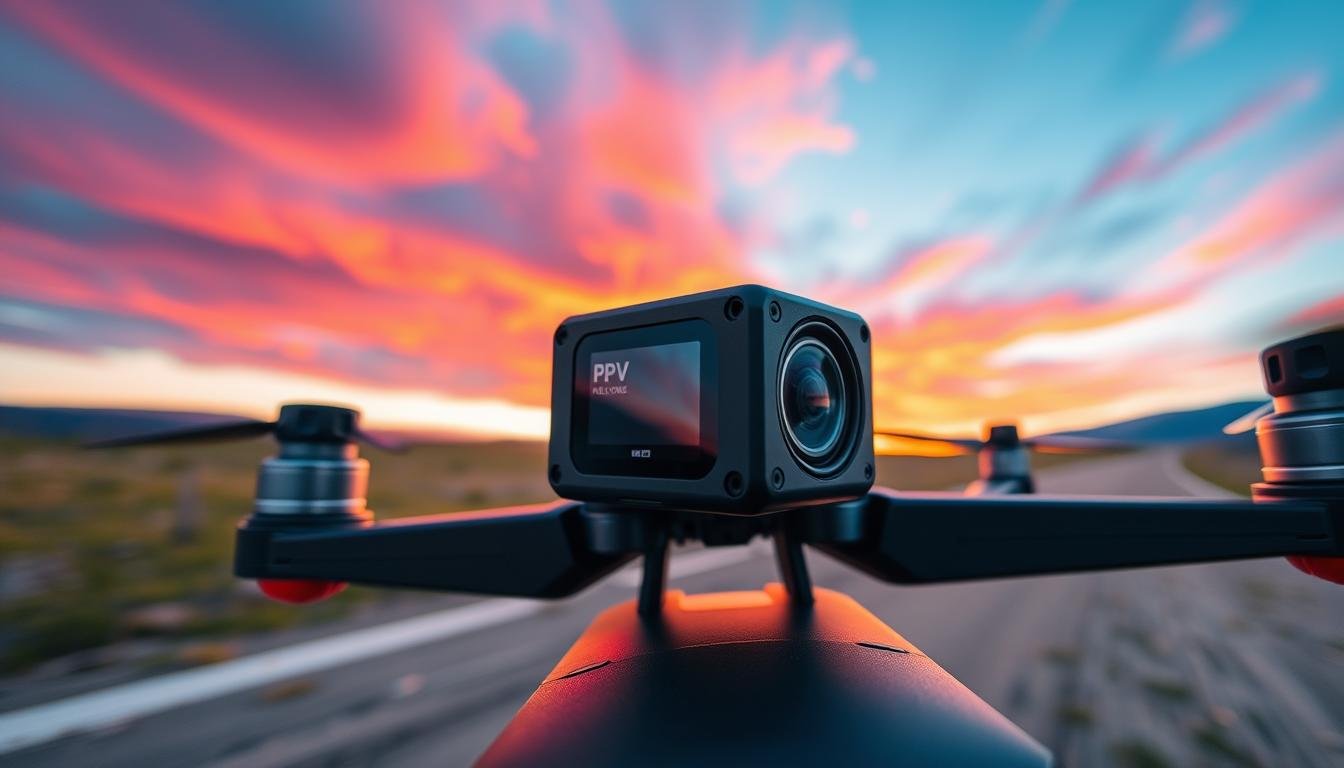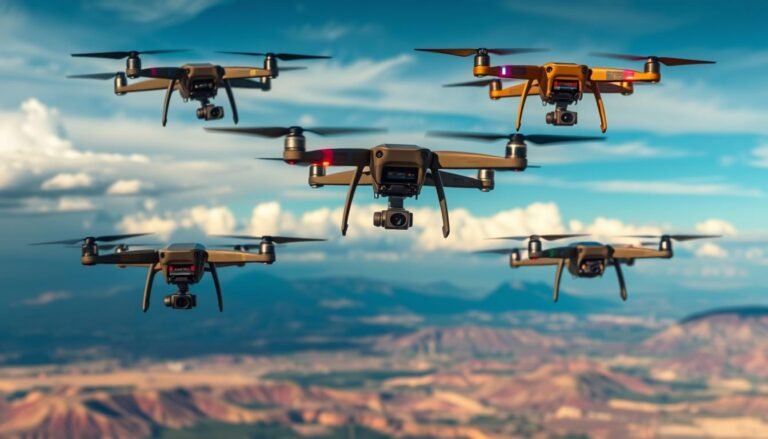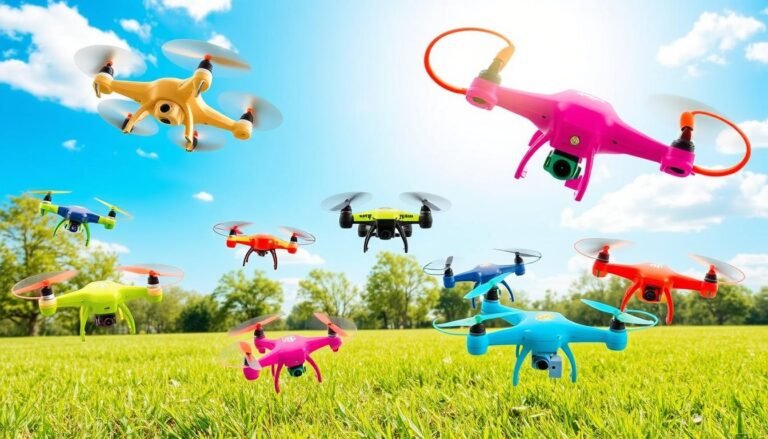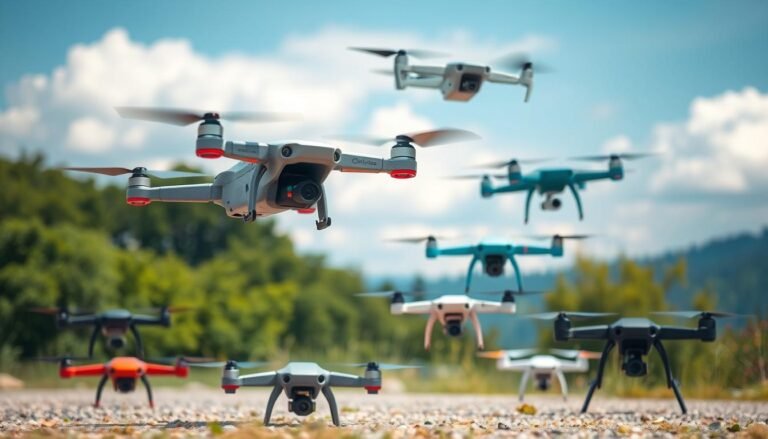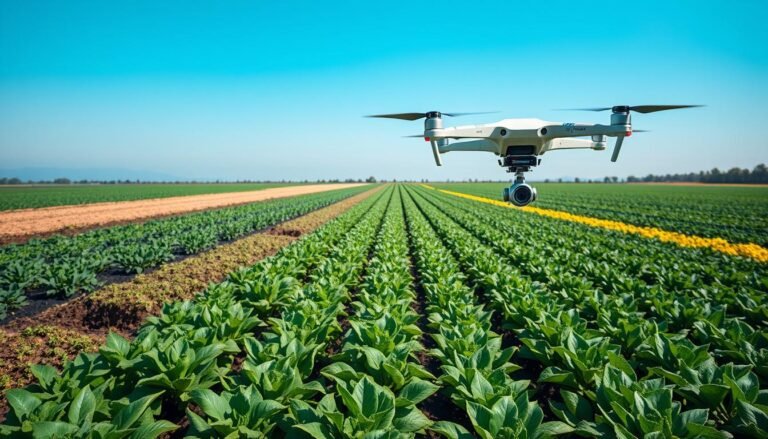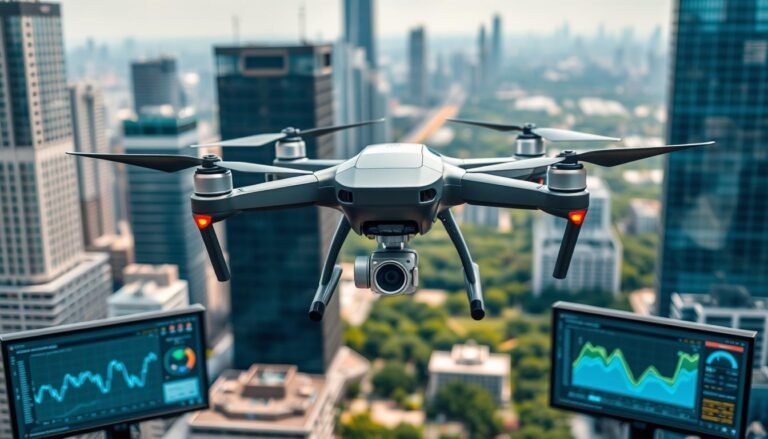Best Drone Racing Cameras for FPV Performance
Top FPV drone racing pilots rely on more than just skill. The right equipment plays a crucial role in their success. A key component is the drone racing camera.
FPV drone racing demands low latency video transmission and high frame rates. These features help pilots navigate complex courses swiftly and accurately. Choosing the best camera can be challenging with numerous options available.
When selecting a drone racing camera, consider resolution, latency, and weight. Digital HD systems offer at least 720p resolution. This provides a clear, detailed view of the course.
Cameras with 120fps have lower latency than 60fps ones. The former has 25-35 ms latency, while the latter has 35-45 ms. Faster frame rates allow for quicker response times.
New technology has led to compact, lightweight cameras. These are vital for maintaining drone speed and agility. The Foxeer Mini Predator 5 is a prime example.
This camera boasts an ultra-low latency of just 4ms. It also features Super Wide Dynamic Range technology. This improves image quality in various lighting conditions.
Key Takeaways:
- Low latency video transmission and high frame rate cameras are essential for competitive FPV drone racing
- Digital HD systems provide at least 720p resolution for clear and detailed views
- 120fps cameras have lower latency compared to 60fps cameras, allowing for faster response times
- Compact and lightweight camera designs are crucial for maintaining drone agility and speed
- Advanced features like WDR technology improve image quality in varying light conditions
Introduction to FPV Drone Racing Cameras
FPV drone racing offers pilots an immersive and thrilling experience. High-performance FPV cameras are at the heart of this exciting sport. These cameras provide low latency video transmission and high frame rates.
FPV cameras are compact and lightweight. They enable pilots to navigate challenging courses and capture stunning aerial footage.
FPV drone racing leagues have gained massive popularity worldwide. MultiGP has over 30,500 registered drone racers across 760 chapters. The Drone Racing League (DRL) partners with T-Mobile for 5G technology.
DRL streams races on NBC, Fox Sports, Sky Sports, and Twitter. FPV cameras offer unique capabilities for fast-paced drone racing.
These cameras can withstand high speeds and tight maneuvers. Some racing drones can reach speeds of up to 150 km/h.
| Camera Type | Key Features | Ideal For |
|---|---|---|
| Racing Drones | Lightweight frames, powerful motors, responsive maneuverability | Competitive racing circuits |
| Freestyle Drones | Durable frames, high-performance components, customizable configurations | Stunts and maneuvers |
| Cinematic Drones | Advanced stabilization systems, high-resolution cameras, long flight times | Capturing smooth, stable footage |
FPV drones have shorter flight times compared to traditional aerial drones. They typically fly for 8-10 minutes, while others can last up to 30 minutes.
The thrill of piloting these agile machines has attracted many enthusiasts. Events like the FAI Drone Racing World Cup showcase the sport’s growing popularity.
As FPV drone racing continues to evolve, so do the innovative cameras that make it possible. The future looks bright for this exciting sport.
Key Features of High-Performance Drone Racing Cameras
Successful drone racing requires the right camera. Low-latency, high-resolution, and small form factor cameras are vital for competitive racers. These advanced technologies help pilots navigate complex courses with precision and speed.
Low Latency Video Transmission
Low-latency cameras are essential for serious drone racers. They minimize delays between drone movements and video feed, providing real-time feedback. With latency as low as 5 milliseconds, pilots can react quickly to obstacles.
Systems like DJI Digital FPV and TBS Crossfire offer low-latency video transmission. These technologies have improved long-range communication in FPV drones. Pilots can now race confidently in challenging environments.
High Frame Rate Recording
High frame rate recording is crucial for drone racing cameras. Cameras with 60fps or higher capture smooth, detailed footage during high-speed maneuvers. This detail helps analyze racing performance and showcase the sport’s excitement.
| Camera | Frame Rate | Resolution |
|---|---|---|
| GoPro Hero10 Black | 120fps | 4K |
| DJI FPV Air Unit Camera | 60fps | 1080p |
| Caddx Vista HD | 120fps | 1080p |
Top-tier drone racing cameras offer high frame rates and resolutions. They capture every race moment in stunning clarity. Professional pilots use these cameras in major events like DRL and MultiGP competitions.
Compact and Lightweight Design
Compact and lightweight designs are crucial for racing drone cameras. Every gram matters when building fast, agile racing drones. Small form factor cameras help minimize the aircraft’s overall weight.
Miniaturized high-definition cameras improve image quality without adding weight. Micro FPV drones, weighing just a few grams, use small cameras for confined spaces. These tiny drones are nimble and responsive.
The key to success in drone racing is having a camera that can keep up with the demands of the sport. Low-latency, high frame rate, and compact designs are the holy grail of FPV camera technology.
The drone racing industry continues to evolve rapidly. We can expect more advanced camera technologies to emerge soon. These innovations will push the boundaries of this thrilling sport.
Top Brands in the Drone Racing Camera Market
Reliable, high-performance cameras are crucial for capturing drone racing excitement. Leading brands offer unique features to help pilots record stunning footage and gain an edge.
GoPro Action Cameras
GoPro cameras are popular among action sports fans and drone racers. Their rugged design and exceptional image quality make them ideal for racing.
The GoPro Hero10 Black records 5.3K video at 60 frames per second. This ensures smooth, detailed footage during high-speed maneuvers.
DJI FPV Cameras
DJI, a drone industry leader, offers FPV cameras designed for racing. Their cameras feature advanced stabilization technology for smooth footage in challenging conditions.
The DJI FPV Air Unit Camera System boasts low-latency video transmission. It can record 4K video at 60 frames per second.
RunCam FPV Cameras
RunCam specializes in compact, lightweight FPV cameras for drone racing. Their cameras offer excellent image quality and low-latency video transmission in a small package.
The RunCam Phoenix Oscar Edition is known for its wide range of customization options. This allows pilots to fine-tune their setup for optimal performance.
Here’s a quick comparison of some popular drone racing cameras:
| Camera | Best For | Camera Quality | Flight Time |
|---|---|---|---|
| iFlight Nazgul XL5 | Overall features | Depends on the build | Up to 18 minutes |
| EMAX Tinyhawk II Freestyle | Value | Good, much better than its predecessor | Four minutes |
| BETAFPV Cetus Pro | Pocket drones | Good but not great | Four to five minutes |
| APEX VR70 | All skill levels | Good but not great | 15-18 minutes |
Consider image quality, latency, weight, and compatibility when choosing a drone racing camera. A trusted brand’s camera will help you capture epic footage of your racing adventures.
Choosing the Right Drone Racing Camera for Your Needs
Selecting best drone racing cameras requires careful consideration. Ensure compatibility with your drone and FPV goggles. This guarantees smooth integration and peak performance.
Video transmission range is vital for racing. Long range video links maintain clear signals during high-speed races. Choose cameras with reliable transmission distances to avoid mid-race signal loss.
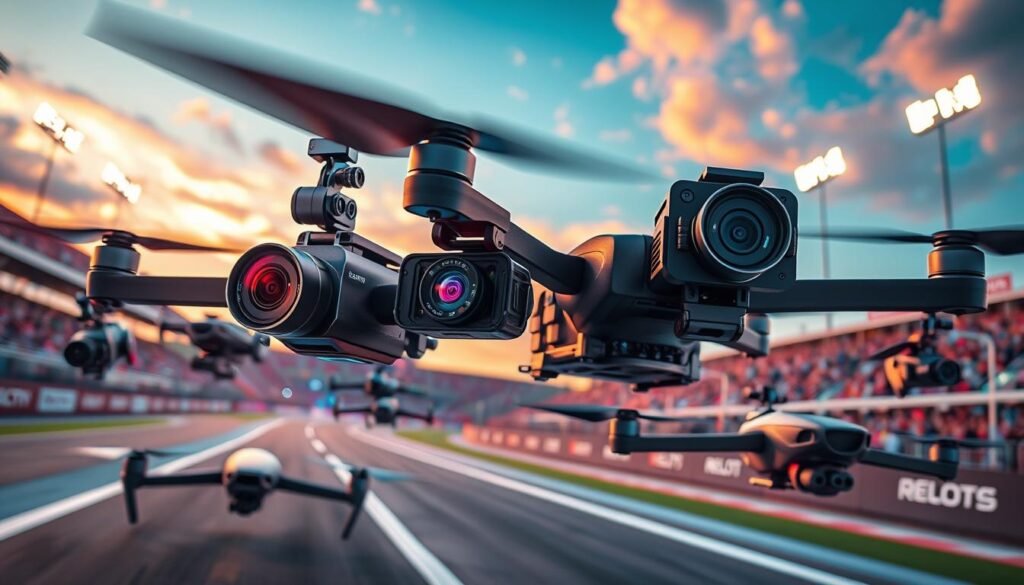
Image quality is crucial for navigation and quick decisions. Look for high-resolution sensors and advanced image processing. These features provide the best visual experience for racing.
Your skill level and goals should guide your camera choice. Beginners may prefer user-friendly, durable options. Experienced pilots might seek advanced features and customization.
- Frame rate: Higher frame rates provide smoother, more responsive video feedback.
- Latency: Low latency is crucial for real-time decision-making and precise control.
- Weight: Lightweight cameras reduce overall drone weight, improving agility and flight times.
Evaluate your needs carefully when selecting a camera. The right choice will boost your FPV experience. It can help you reach your full potential as a pilot.
Best Drone Racing Cameras for Beginners
Picking the right FPV camera is key for new drone racers. The Eachine TX01 and RunCam Phoenix Oscar Edition are great starter options. They offer good performance, easy use, and fair prices.
Eachine TX01 FPV Camera
The Eachine TX01 is a top pick for new FPV pilots. It’s small and works well. The camera has 600TVL resolution for clear video.
Its wide-angle lens offers a 120-degree view. This helps pilots fly through tight spots. The TX01 weighs only 3.5g, which is very light.
It has a built-in OSD to show flight info. Pilots can see battery life, flight time, and signal strength on screen.
RunCam Phoenix Oscar Edition FPV Camera
The RunCam Phoenix Oscar Edition is another great beginner camera. It has 1000TVL resolution for sharp video. Its 2.1mm lens gives a wide 150-degree view.
This camera uses WDR tech for better images in different light. It keeps good visibility in tough settings. The Phoenix also supports OSD for custom flight data.
| Camera | Resolution | Field of View | Weight | Key Features |
|---|---|---|---|---|
| Eachine TX01 | 600TVL | 120° | 3.5g | Built-in OSD, Compact size |
| RunCam Phoenix Oscar Edition | 1000TVL | 1000TVL | 5.5g | WDR Technology, OSD support |
Look at image quality, view width, weight, and extra features when choosing an FPV camera. The Eachine TX01 and RunCam Phoenix Oscar Edition are great for new pilots.
Advanced Drone Racing Cameras for Experienced Pilots
Every millisecond counts in drone racing. Advanced FPV cameras are crucial for maintaining a competitive edge. They offer top-notch performance and cutting-edge features for demanding racing conditions.
These high-end cameras deliver clear video feeds and fast transmission. Their reliability is unbeatable, even in the toughest races.
GoPro Hero10 Black Action Camera
The GoPro Hero10 Black is a favorite among pro drone racers. It captures stunning footage with 5.3K video resolution and HyperSmooth 4.0 stabilization.
Its rugged design fits perfectly on racing drones. The Hero10 Black’s intuitive controls allow for quick adjustments during flights.
DJI FPV Air Unit Camera System
DJI’s FPV Air Unit Camera System is an all-in-one solution for serious racers. It combines a high-def camera with a low-latency transmitter and robust receiver.
The system ensures seamless video transmission with minimal delay. Its 150° ultra-wide-angle lens provides an immersive view and smooth 1080p/60fps footage.
Caddx Vista HD FPV Camera
The Caddx Vista HD FPV Camera is a top choice for demanding pilots. Its 1/1.8″ CMOS sensor captures vivid colors and fine details in low light.
With a 150° field of view, it offers an immersive FPV experience. The Vista HD’s lightweight design withstands the rigors of drone racing.
These advanced cameras give pilots the edge they need. They help racers push their limits and dominate the competition.
Accessories and Upgrades for Drone Racing Cameras
FPV camera add-ons can boost your drone racing experience. They enhance your camera’s abilities and toughness. These extras help you capture great footage during intense races.
A sturdy camera mount is crucial. It keeps your camera steady on the drone. This reduces shaking and ensures clear video transmission.
Popular mounts include the SEQURE SQFPV Heison 5X & 5D for $499.00. A cheaper option is the ELRS 2.4GHz Dual RX & 80mm*2 receiver at $15.90.
ND filters are another useful accessory. They cut down light entering the lens. This results in smoother, more cinematic footage in bright conditions.
ND filters also reduce motion blur. They come in various strengths for different lighting situations.
Lens protectors shield your camera from scratches and impacts. Replacement lenses let you try different views. Power cables ensure your camera stays on during races.
“Investing in high-quality FPV camera accessories can make a world of difference in your drone racing experience. From sturdy mounts to ND filters, these upgrades will help you capture stunning footage and gain a competitive edge on the track.”
Choose accessories that fit your camera and are tough. Prices range from $5.99 to $79.99. There are options for every budget and skill level.
Pick the right add-ons to unlock your camera’s potential. This will take your drone racing videos to new heights.
Setting Up and Optimizing Your Drone Racing Camera
A proper FPV camera setup is key for top performance in drone racing. Focus on camera mounting, positioning, and fine-tuning settings. These adjustments can greatly boost your FPV flying and racing skills.
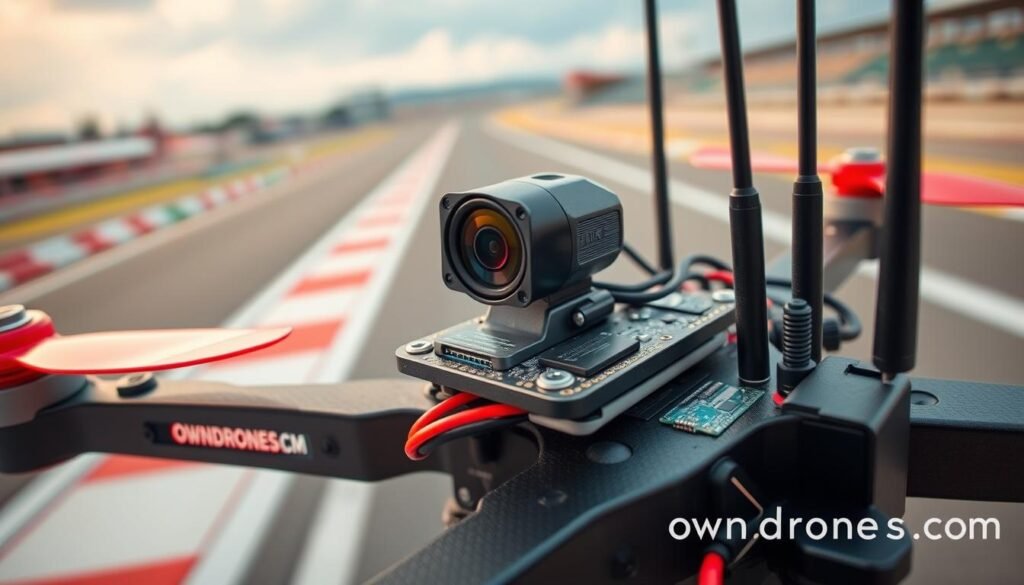
Mounting and Positioning Tips
Secure your FPV camera firmly to your drone frame. Carbon fiber frames are light, strong, and common in FPV drones. They have top and bottom plates with 4 arms in an “X” shape.
Here are some tips for optimal camera mounting:
- Position the camera at the correct angle for your flying style
- Ensure the camera is firmly attached to prevent vibrations and shaking
- Use appropriate mounting hardware, such as 3D printed mounts or damping balls
Good camera positioning helps detect obstacles and prevent crashes. FPV cameras send live video to the pilot’s goggles or monitor. This creates an immersive flying experience.
Micro FPV drones are small and agile. They work well for indoor flying. These drones need precise camera positioning for best results.
Camera Settings for Optimal FPV Performance
Adjusting your camera settings is crucial for top FPV performance. Consider these key settings:
| Setting | Recommendation |
|---|---|
| Exposure | Adjust based on lighting conditions |
| White Balance | Set to auto or adjust manually for consistent colors |
| Field of View (FOV) | Choose a wide FOV for increased peripheral vision |
| Resolution | Select high resolution for detailed footage |
| Frame Rate | Opt for high frame rates (e.g., 60fps) for smooth video |
Fine-tuning these settings will greatly improve your FPV experience. It will also boost your racing performance. FPV drones can reach speeds up to 120 km/h.
Proper camera setup is vital for smooth video and control during high-speed moves.
Maintenance and Troubleshooting for Drone Racing Cameras
Regular FPV camera maintenance prevents costly malfunctions and ensures reliable functioning. Keep your FPV camera in top shape for optimal race performance. Here are essential tips for maintaining and troubleshooting FPV cameras:
Cleaning FPV lenses is crucial for camera upkeep. Use a soft, microfiber cloth to remove dust and smudges gently. Avoid harsh chemicals or abrasive materials that could scratch the lens.
Inspect your camera’s connections and settings regularly. Ensure all cables are securely attached and undamaged. Check your camera’s compatibility with other components to avoid potential issues.
Double-check compatibility with the flight controller and video transmitter. This step helps prevent problems before they arise.
| Maintenance Task | Frequency |
|---|---|
| Clean FPV lens | Before every flight |
| Check camera connections | Before every flight |
| Inspect camera settings | Before every flight |
| Update camera firmware | As needed |
Facing video feed interruptions or poor image quality? Try these troubleshooting steps:
- Verify that your camera’s antenna is properly connected and oriented
- Check for any loose or damaged wiring
- Ensure that your camera’s settings, such as resolution and frame rate, are configured correctly
- Test your camera with a different video receiver to isolate the problem
Prevention is better than cure when it comes to FPV camera maintenance. By taking proactive steps to care for your camera, you can minimize the risk of failures during critical moments in a race.
A well-maintained FPV camera boosts racing performance and extends equipment lifespan. Regular upkeep and prompt issue resolution keep your camera in top shape.
Dedicate time to maintenance and address problems quickly. Your drone racing camera will stay in optimal condition for peak performance.
Future Trends in Drone Racing Camera Technology
Drone racing cameras are evolving rapidly. FPV cameras are advancing, promising a more thrilling experience for pilots and viewers. These improvements will make races even more exciting and immersive.
The racing drone market is set to explode. It’s expected to reach USD 2,238.1 million by 2033, up from USD 416.9 million in 2023. This growth is driven by new tech and increased investment in the industry.
In 2022 alone, drone companies attracted USD 1.54 billion in funding. This influx of capital is fueling innovation and expansion in the field.
Higher Resolution Sensors
High-resolution sensors are coming to FPV cameras. 4K and higher resolutions will offer pilots incredible detail and clarity during flights. This visual upgrade will improve racing and enable more precise navigation.
Improved Low-Light Performance
FPV cameras are getting better at low-light performance. Night races and indoor events are becoming more popular. This creates demand for cameras that work well in dim conditions.
New sensor tech and image processing will help pilots fly confidently in dark environments. This opens up exciting possibilities for thrilling races and stunning cinematography.
| Market Segment | 2023 Market Share | Key Drivers |
|---|---|---|
| Batteries/FPV Goggles | 49% | Advancements in battery technology and increased adoption of FPV goggles |
| Ready-to-Fly (RTF) Drones | 68% | Ease of use and appeal to both novice flyers and experienced enthusiasts |
| Rotorcross | 43% | Growing popularity of Rotorcross competitions and demand for agile racing drones |
The future of FPV cameras is bright and exciting. High-resolution sensors and better low-light performance are leading the way. These advancements will take drone racing to new heights.
Conclusion
Choosing the right FPV camera is crucial for drone racing success. It impacts your performance and overall experience. The growing popularity of drone racing has increased demand for top-notch FPV cameras.
Key features to consider include low latency video transmission and high frame rates. Look for compact, lightweight designs too. GoPro, DJI, and RunCam offer cameras for various skill levels and budgets.
Beginners might prefer the Eachine TX01 or RunCam Phoenix Oscar Edition. Advanced pilots could opt for the GoPro Hero10 Black or DJI FPV Air Unit Camera System.
Proper camera setup is essential for optimal performance. This includes correct mounting, positioning, and settings. Regular maintenance ensures your camera works at its best.
As technology advances, we’ll see higher resolution sensors and better low-light performance. Investing in the right FPV camera equips you for stunning aerial footage and top-level competition.
